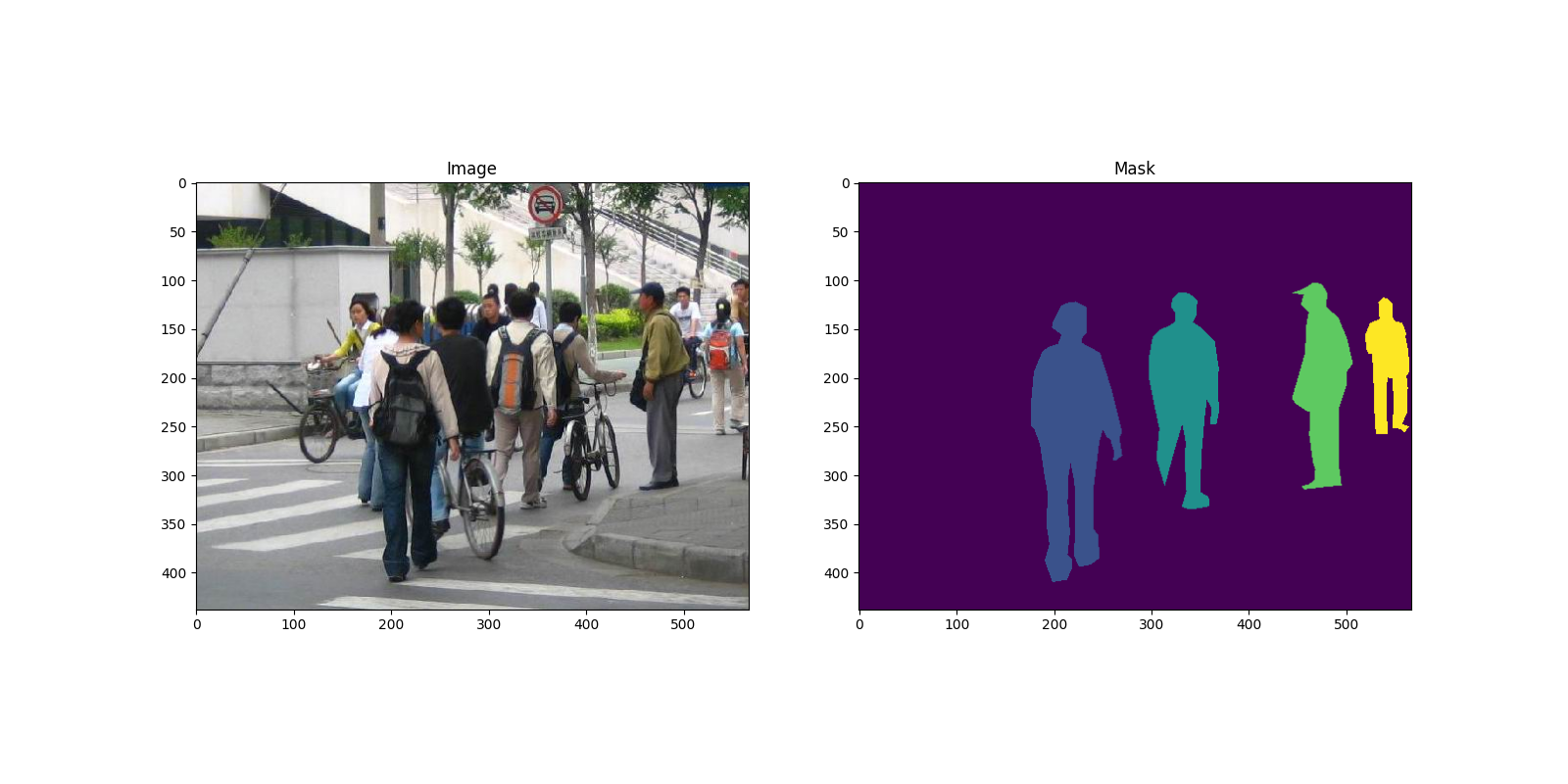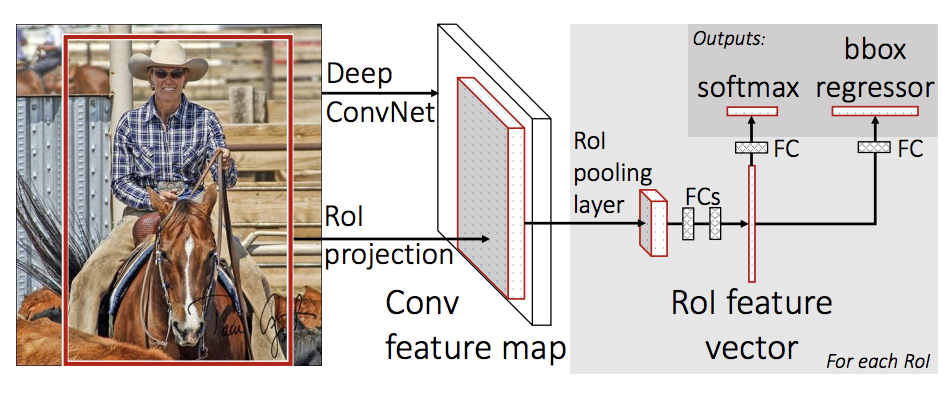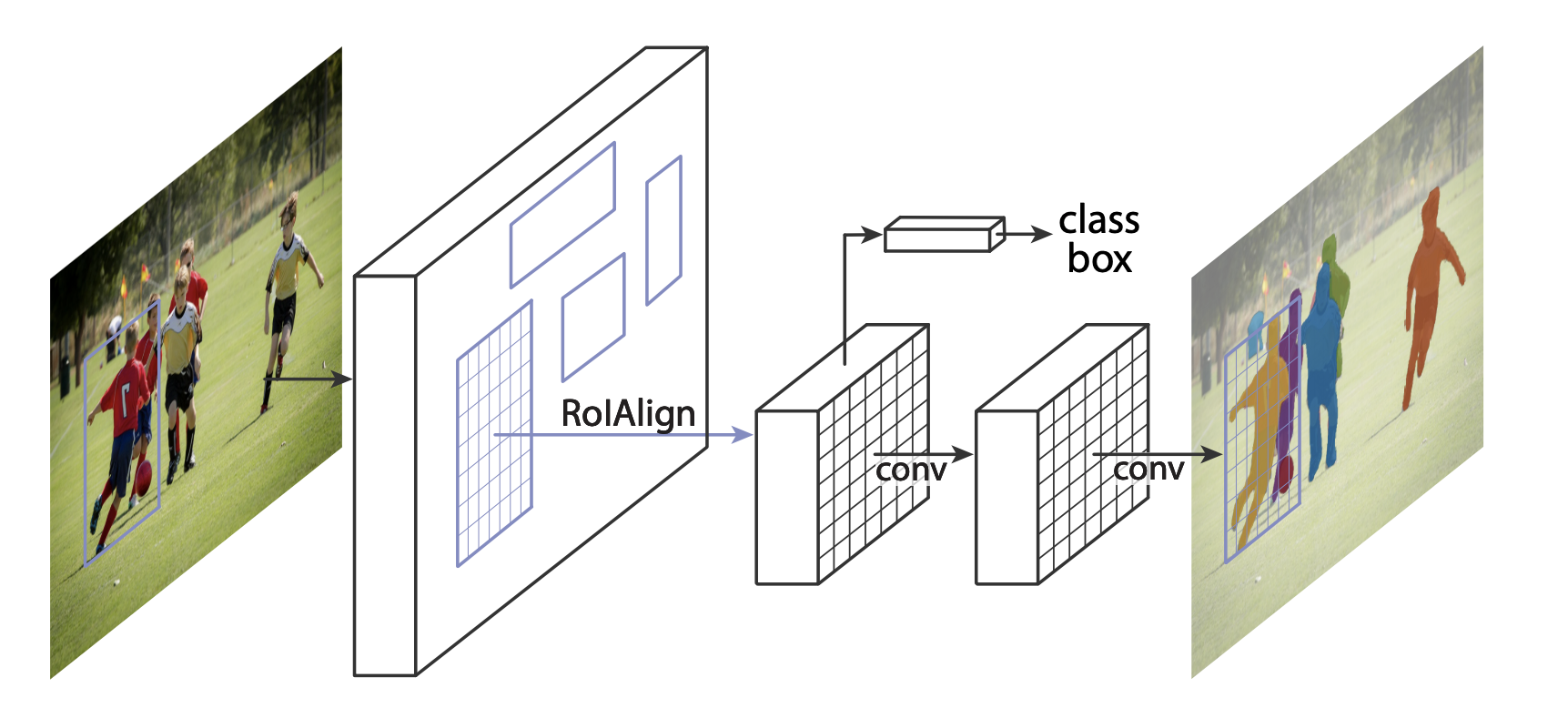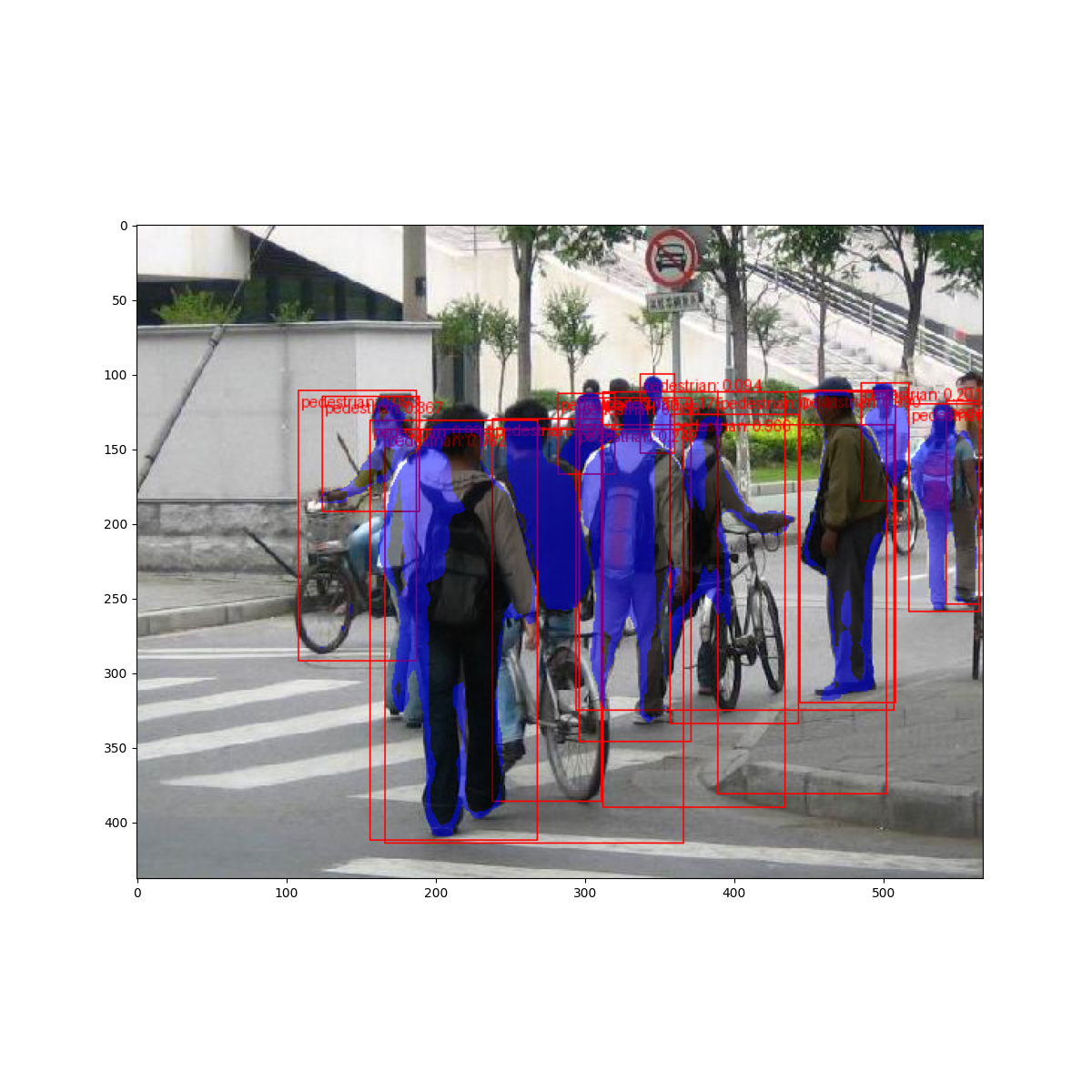注意
单击此处下载完整的示例代码
TorchVision 对象检测微调教程¶
创建时间: 2023年12月14日 |上次更新时间:2024 年 6 月 11 日 |上次验证: Nov 05, 2024
在本教程中,我们将微调预训练的 Mask 宾夕法尼亚大学-复旦大学的 R-CNN 模型 行人检测数据库和 分段。它包含 170 张图像,其中包含 345 个行人实例,我们将使用它来 演示如何使用 TorchVision 中的新功能进行训练 自定义数据集上的对象检测和实例分段模型。
注意
本教程仅适用于 torchvision 版本 >=0.16 或 nightly。 如果您使用的是 torchvision<=0.15,请遵循本教程。
定义数据集¶
用于训练对象检测的参考脚本,实例
细分和人员关键点检测可轻松支持
添加新的自定义数据集。数据集应继承自标准的torch.utils.data.Dataset类、实现和 .__len____getitem__
我们唯一需要的特异性是 dataset 应该返回一个 Tuples:__getitem__
图像:
torchvision.tv_tensors.Image形状 、 纯张量 或 PIL 大小的 图像[3, H, W](H, W)target:包含以下字段的 dict
boxes,torchvision.tv_tensors.BoundingBoxes形状 : 格式为边界框的坐标,范围从 to 和 to[N, 4]N[x0, y0, x1, y1]0W0Hlabels整数torch.Tensorof shape :每个边界框的标签。 始终表示 Background 类。[N]0image_id, int:图片标识符。它应该是 在数据集中的所有图像之间是唯一的,并在 评估area浮torch.Tensorof shape :边界框的区域。这是用的 在使用 COCO 指标进行评估期间,将指标分开 小、中、大箱子之间的分数。[N]iscrowd、uint8torch.Tensorof shape : 实例 将为 在评估过程中被忽略。[N]iscrowd=True(可选) 、
maskstorchvision.tv_tensors.Mask的形状 :分段 每个对象的掩码[N, H, W]
如果您的数据集符合上述要求,那么它将适用于两者
参考脚本中的训练和评估代码。评估代码将使用脚本,这些脚本可以从中安装 。pycocotoolspip install pycocotools
注意
对于 Windows,请使用 command 从 gautamchitnis 安装pycocotools
pip install git+https://github.com/gautamchitnis/cocoapi.git@cocodataset-master#subdirectory=PythonAPI
关于 .该模型将 class 视为 background。如果您的数据集不包含 background 类,则
你不应该在你的 .例如,假设你只有两个类 cat 和 dog,你可以
define (not ) 来表示 cats 和 to represent dogs。因此,例如,如果其中一个图像同时具有
类,则 Tensor 应如下所示。labels00labels102labels[1, 2]
此外,如果您想在训练期间使用纵横比分组
(以便每个批次仅包含具有相似纵横比的图像),
然后,建议还实现一个方法,该方法返回图像的高度和宽度。如果此
方法,我们通过 查询数据集的所有元素,这会将图像加载到内存中,并且比 if
提供了自定义方法。get_height_and_width__getitem__
为 PennFudan 编写自定义数据集¶
让我们为 PennFudan 数据集编写一个数据集。首先,让我们下载数据集,然后 解压缩 zip 文件:
wget https://www.cis.upenn.edu/~jshi/ped_html/PennFudanPed.zip -P data
cd data && unzip PennFudanPed.zip
我们有以下文件夹结构:
PennFudanPed/
PedMasks/
FudanPed00001_mask.png
FudanPed00002_mask.png
FudanPed00003_mask.png
FudanPed00004_mask.png
...
PNGImages/
FudanPed00001.png
FudanPed00002.png
FudanPed00003.png
FudanPed00004.png
以下是一对图像和分割蒙版的一个示例
import matplotlib.pyplot as plt
from torchvision.io import read_image
image = read_image("data/PennFudanPed/PNGImages/FudanPed00046.png")
mask = read_image("data/PennFudanPed/PedMasks/FudanPed00046_mask.png")
plt.figure(figsize=(16, 8))
plt.subplot(121)
plt.title("Image")
plt.imshow(image.permute(1, 2, 0))
plt.subplot(122)
plt.title("Mask")
plt.imshow(mask.permute(1, 2, 0))

<matplotlib.image.AxesImage object at 0x7f4edba7ae30>
所以每张图像都有一个对应的
Segmentation Mask 的 Segmentation Mask 中,每种颜色对应一个不同的实例。
让我们编写一个torch.utils.data.Dataset类。
在下面的代码中,我们将图像、边界框和蒙版包装到torchvision.tv_tensors.TVTensor类,以便我们能够应用 TorchVision
内置转换(新的 Transforms API)
对于给定的对象检测和分段任务。
也就是说,图像张量将被torchvision.tv_tensors.Image、边界框torchvision.tv_tensors.BoundingBoxes和掩码放入torchvision.tv_tensors.Mask.
如torchvision.tv_tensors.TVTensor是torch.Tensor子类中,包装的对象也是张量并继承了 plaintorch.Tensor应用程序接口。有关 torchvision 的更多信息,请参阅此文档。tv_tensors
import os
import torch
from torchvision.io import read_image
from torchvision.ops.boxes import masks_to_boxes
from torchvision import tv_tensors
from torchvision.transforms.v2 import functional as F
class PennFudanDataset(torch.utils.data.Dataset):
def __init__(self, root, transforms):
self.root = root
self.transforms = transforms
# load all image files, sorting them to
# ensure that they are aligned
self.imgs = list(sorted(os.listdir(os.path.join(root, "PNGImages"))))
self.masks = list(sorted(os.listdir(os.path.join(root, "PedMasks"))))
def __getitem__(self, idx):
# load images and masks
img_path = os.path.join(self.root, "PNGImages", self.imgs[idx])
mask_path = os.path.join(self.root, "PedMasks", self.masks[idx])
img = read_image(img_path)
mask = read_image(mask_path)
# instances are encoded as different colors
obj_ids = torch.unique(mask)
# first id is the background, so remove it
obj_ids = obj_ids[1:]
num_objs = len(obj_ids)
# split the color-encoded mask into a set
# of binary masks
masks = (mask == obj_ids[:, None, None]).to(dtype=torch.uint8)
# get bounding box coordinates for each mask
boxes = masks_to_boxes(masks)
# there is only one class
labels = torch.ones((num_objs,), dtype=torch.int64)
image_id = idx
area = (boxes[:, 3] - boxes[:, 1]) * (boxes[:, 2] - boxes[:, 0])
# suppose all instances are not crowd
iscrowd = torch.zeros((num_objs,), dtype=torch.int64)
# Wrap sample and targets into torchvision tv_tensors:
img = tv_tensors.Image(img)
target = {}
target["boxes"] = tv_tensors.BoundingBoxes(boxes, format="XYXY", canvas_size=F.get_size(img))
target["masks"] = tv_tensors.Mask(masks)
target["labels"] = labels
target["image_id"] = image_id
target["area"] = area
target["iscrowd"] = iscrowd
if self.transforms is not None:
img, target = self.transforms(img, target)
return img, target
def __len__(self):
return len(self.imgs)
这就是数据集的全部内容。现在让我们定义一个可以执行 预测。
定义模型¶
在本教程中,我们将使用 Mask R-CNN,它基于 Faster R-CNN 之上。更快的 R-CNN 是一个 预测潜在边界框和类分数的模型 对象。

掩码 R-CNN 添加了一个额外的分支 转换为 Faster R-CNN,它还预测每个 实例。

有两种常见的 人们可能想要的情况 以修改 TorchVision Model Zoo 中的可用模型之一。第一个 是当我们想要从预先训练的模型开始,然后微调 最后一层。另一种是当我们想替换 模型替换为其他模型(例如,为了更快地进行预测)。
让我们看看在以下部分中我们将如何执行一个或另一个作。
1 - 从预训练模型进行微调¶
假设您想从 COCO 上预训练的模型开始 并希望针对您的特定类对其进行微调。这是一个可能的 方法:
import torchvision
from torchvision.models.detection.faster_rcnn import FastRCNNPredictor
# load a model pre-trained on COCO
model = torchvision.models.detection.fasterrcnn_resnet50_fpn(weights="DEFAULT")
# replace the classifier with a new one, that has
# num_classes which is user-defined
num_classes = 2 # 1 class (person) + background
# get number of input features for the classifier
in_features = model.roi_heads.box_predictor.cls_score.in_features
# replace the pre-trained head with a new one
model.roi_heads.box_predictor = FastRCNNPredictor(in_features, num_classes)
Downloading: "https://download.pytorch.org/models/fasterrcnn_resnet50_fpn_coco-258fb6c6.pth" to /var/lib/ci-user/.cache/torch/hub/checkpoints/fasterrcnn_resnet50_fpn_coco-258fb6c6.pth
0%| | 0.00/160M [00:00<?, ?B/s]
27%|##6 | 42.8M/160M [00:00<00:00, 448MB/s]
54%|#####4 | 86.8M/160M [00:00<00:00, 456MB/s]
82%|########1 | 131M/160M [00:00<00:00, 458MB/s]
100%|##########| 160M/160M [00:00<00:00, 457MB/s]
2 - 修改模型以添加不同的主干¶
import torchvision
from torchvision.models.detection import FasterRCNN
from torchvision.models.detection.rpn import AnchorGenerator
# load a pre-trained model for classification and return
# only the features
backbone = torchvision.models.mobilenet_v2(weights="DEFAULT").features
# ``FasterRCNN`` needs to know the number of
# output channels in a backbone. For mobilenet_v2, it's 1280
# so we need to add it here
backbone.out_channels = 1280
# let's make the RPN generate 5 x 3 anchors per spatial
# location, with 5 different sizes and 3 different aspect
# ratios. We have a Tuple[Tuple[int]] because each feature
# map could potentially have different sizes and
# aspect ratios
anchor_generator = AnchorGenerator(
sizes=((32, 64, 128, 256, 512),),
aspect_ratios=((0.5, 1.0, 2.0),)
)
# let's define what are the feature maps that we will
# use to perform the region of interest cropping, as well as
# the size of the crop after rescaling.
# if your backbone returns a Tensor, featmap_names is expected to
# be [0]. More generally, the backbone should return an
# ``OrderedDict[Tensor]``, and in ``featmap_names`` you can choose which
# feature maps to use.
roi_pooler = torchvision.ops.MultiScaleRoIAlign(
featmap_names=['0'],
output_size=7,
sampling_ratio=2
)
# put the pieces together inside a Faster-RCNN model
model = FasterRCNN(
backbone,
num_classes=2,
rpn_anchor_generator=anchor_generator,
box_roi_pool=roi_pooler
)
Downloading: "https://download.pytorch.org/models/mobilenet_v2-7ebf99e0.pth" to /var/lib/ci-user/.cache/torch/hub/checkpoints/mobilenet_v2-7ebf99e0.pth
0%| | 0.00/13.6M [00:00<?, ?B/s]
100%|##########| 13.6M/13.6M [00:00<00:00, 381MB/s]
PennFudan 数据集的目标检测和实例分割模型¶
在我们的例子中,我们希望从预训练模型进行微调,因为 我们的数据集非常小,因此我们将遵循第 1 种方法。
在这里,我们还想计算实例分段掩码,因此我们将 正在使用 Mask R-CNN:
import torchvision
from torchvision.models.detection.faster_rcnn import FastRCNNPredictor
from torchvision.models.detection.mask_rcnn import MaskRCNNPredictor
def get_model_instance_segmentation(num_classes):
# load an instance segmentation model pre-trained on COCO
model = torchvision.models.detection.maskrcnn_resnet50_fpn(weights="DEFAULT")
# get number of input features for the classifier
in_features = model.roi_heads.box_predictor.cls_score.in_features
# replace the pre-trained head with a new one
model.roi_heads.box_predictor = FastRCNNPredictor(in_features, num_classes)
# now get the number of input features for the mask classifier
in_features_mask = model.roi_heads.mask_predictor.conv5_mask.in_channels
hidden_layer = 256
# and replace the mask predictor with a new one
model.roi_heads.mask_predictor = MaskRCNNPredictor(
in_features_mask,
hidden_layer,
num_classes
)
return model
就是这样,这将准备好接受培训和评估
在您的自定义数据集上。model
把所有东西放在一起¶
在 中,我们有许多辅助函数
简化检测模型的训练和评估。在这里,我们将使用 和 。
只需将下的所有内容下载到您的文件夹中并在此处使用它们。
在 Linux 上(如果有),您可以使用以下命令下载它们:references/detection/references/detection/engine.pyreferences/detection/utils.pyreferences/detectionwget
os.system("wget https://raw.githubusercontent.com/pytorch/vision/main/references/detection/engine.py")
os.system("wget https://raw.githubusercontent.com/pytorch/vision/main/references/detection/utils.py")
os.system("wget https://raw.githubusercontent.com/pytorch/vision/main/references/detection/coco_utils.py")
os.system("wget https://raw.githubusercontent.com/pytorch/vision/main/references/detection/coco_eval.py")
os.system("wget https://raw.githubusercontent.com/pytorch/vision/main/references/detection/transforms.py")
0
从 v0.15.0 开始,torchvision 提供了新的 Transforms API,可以轻松地为对象检测和分割任务编写数据增强管道。
让我们编写一些用于数据增强的辅助函数 / 转型:
from torchvision.transforms import v2 as T
def get_transform(train):
transforms = []
if train:
transforms.append(T.RandomHorizontalFlip(0.5))
transforms.append(T.ToDtype(torch.float, scale=True))
transforms.append(T.ToPureTensor())
return T.Compose(transforms)
测试方法(可选)forward()¶
在迭代数据集之前,最好先看看模型是什么 expects 期间对样本数据进行训练和推理。
import utils
model = torchvision.models.detection.fasterrcnn_resnet50_fpn(weights="DEFAULT")
dataset = PennFudanDataset('data/PennFudanPed', get_transform(train=True))
data_loader = torch.utils.data.DataLoader(
dataset,
batch_size=2,
shuffle=True,
collate_fn=utils.collate_fn
)
# For Training
images, targets = next(iter(data_loader))
images = list(image for image in images)
targets = [{k: v for k, v in t.items()} for t in targets]
output = model(images, targets) # Returns losses and detections
print(output)
# For inference
model.eval()
x = [torch.rand(3, 300, 400), torch.rand(3, 500, 400)]
predictions = model(x) # Returns predictions
print(predictions[0])
{'loss_classifier': tensor(0.0808, grad_fn=<NllLossBackward0>), 'loss_box_reg': tensor(0.0284, grad_fn=<DivBackward0>), 'loss_objectness': tensor(0.0186, grad_fn=<BinaryCrossEntropyWithLogitsBackward0>), 'loss_rpn_box_reg': tensor(0.0034, grad_fn=<DivBackward0>)}
{'boxes': tensor([], size=(0, 4), grad_fn=<StackBackward0>), 'labels': tensor([], dtype=torch.int64), 'scores': tensor([], grad_fn=<IndexBackward0>)}
现在让我们编写执行训练的 main 函数和 验证:
from engine import train_one_epoch, evaluate
# train on the GPU or on the CPU, if a GPU is not available
device = torch.device('cuda') if torch.cuda.is_available() else torch.device('cpu')
# our dataset has two classes only - background and person
num_classes = 2
# use our dataset and defined transformations
dataset = PennFudanDataset('data/PennFudanPed', get_transform(train=True))
dataset_test = PennFudanDataset('data/PennFudanPed', get_transform(train=False))
# split the dataset in train and test set
indices = torch.randperm(len(dataset)).tolist()
dataset = torch.utils.data.Subset(dataset, indices[:-50])
dataset_test = torch.utils.data.Subset(dataset_test, indices[-50:])
# define training and validation data loaders
data_loader = torch.utils.data.DataLoader(
dataset,
batch_size=2,
shuffle=True,
collate_fn=utils.collate_fn
)
data_loader_test = torch.utils.data.DataLoader(
dataset_test,
batch_size=1,
shuffle=False,
collate_fn=utils.collate_fn
)
# get the model using our helper function
model = get_model_instance_segmentation(num_classes)
# move model to the right device
model.to(device)
# construct an optimizer
params = [p for p in model.parameters() if p.requires_grad]
optimizer = torch.optim.SGD(
params,
lr=0.005,
momentum=0.9,
weight_decay=0.0005
)
# and a learning rate scheduler
lr_scheduler = torch.optim.lr_scheduler.StepLR(
optimizer,
step_size=3,
gamma=0.1
)
# let's train it just for 2 epochs
num_epochs = 2
for epoch in range(num_epochs):
# train for one epoch, printing every 10 iterations
train_one_epoch(model, optimizer, data_loader, device, epoch, print_freq=10)
# update the learning rate
lr_scheduler.step()
# evaluate on the test dataset
evaluate(model, data_loader_test, device=device)
print("That's it!")
Downloading: "https://download.pytorch.org/models/maskrcnn_resnet50_fpn_coco-bf2d0c1e.pth" to /var/lib/ci-user/.cache/torch/hub/checkpoints/maskrcnn_resnet50_fpn_coco-bf2d0c1e.pth
0%| | 0.00/170M [00:00<?, ?B/s]
25%|##5 | 42.8M/170M [00:00<00:00, 448MB/s]
52%|#####1 | 87.5M/170M [00:00<00:00, 460MB/s]
78%|#######7 | 132M/170M [00:00<00:00, 463MB/s]
100%|##########| 170M/170M [00:00<00:00, 462MB/s]
/var/lib/workspace/intermediate_source/engine.py:30: FutureWarning:
`torch.cuda.amp.autocast(args...)` is deprecated. Please use `torch.amp.autocast('cuda', args...)` instead.
Epoch: [0] [ 0/60] eta: 0:00:23 lr: 0.000090 loss: 4.9024 (4.9024) loss_classifier: 0.4325 (0.4325) loss_box_reg: 0.1060 (0.1060) loss_mask: 4.3588 (4.3588) loss_objectness: 0.0028 (0.0028) loss_rpn_box_reg: 0.0023 (0.0023) time: 0.3958 data: 0.0135 max mem: 2430
Epoch: [0] [10/60] eta: 0:00:11 lr: 0.000936 loss: 1.7743 (2.7696) loss_classifier: 0.4134 (0.3553) loss_box_reg: 0.3051 (0.2540) loss_mask: 0.9491 (2.1320) loss_objectness: 0.0218 (0.0214) loss_rpn_box_reg: 0.0056 (0.0069) time: 0.2267 data: 0.0151 max mem: 2594
Epoch: [0] [20/60] eta: 0:00:08 lr: 0.001783 loss: 0.8078 (1.7882) loss_classifier: 0.2145 (0.2678) loss_box_reg: 0.2062 (0.2328) loss_mask: 0.3990 (1.2594) loss_objectness: 0.0134 (0.0202) loss_rpn_box_reg: 0.0076 (0.0080) time: 0.2064 data: 0.0154 max mem: 2628
Epoch: [0] [30/60] eta: 0:00:06 lr: 0.002629 loss: 0.6568 (1.4240) loss_classifier: 0.1409 (0.2251) loss_box_reg: 0.2294 (0.2425) loss_mask: 0.2605 (0.9280) loss_objectness: 0.0122 (0.0186) loss_rpn_box_reg: 0.0101 (0.0099) time: 0.2106 data: 0.0163 max mem: 2772
Epoch: [0] [40/60] eta: 0:00:04 lr: 0.003476 loss: 0.5629 (1.2055) loss_classifier: 0.0928 (0.1906) loss_box_reg: 0.2512 (0.2357) loss_mask: 0.2267 (0.7537) loss_objectness: 0.0076 (0.0156) loss_rpn_box_reg: 0.0119 (0.0098) time: 0.2101 data: 0.0167 max mem: 2772
Epoch: [0] [50/60] eta: 0:00:02 lr: 0.004323 loss: 0.3608 (1.0399) loss_classifier: 0.0590 (0.1624) loss_box_reg: 0.1578 (0.2174) loss_mask: 0.1602 (0.6378) loss_objectness: 0.0019 (0.0130) loss_rpn_box_reg: 0.0071 (0.0093) time: 0.2051 data: 0.0161 max mem: 2772
Epoch: [0] [59/60] eta: 0:00:00 lr: 0.005000 loss: 0.3463 (0.9410) loss_classifier: 0.0383 (0.1445) loss_box_reg: 0.1258 (0.2049) loss_mask: 0.1596 (0.5712) loss_objectness: 0.0015 (0.0115) loss_rpn_box_reg: 0.0064 (0.0089) time: 0.2012 data: 0.0153 max mem: 2772
Epoch: [0] Total time: 0:00:12 (0.2094 s / it)
creating index...
index created!
Test: [ 0/50] eta: 0:00:04 model_time: 0.0785 (0.0785) evaluator_time: 0.0074 (0.0074) time: 0.0988 data: 0.0124 max mem: 2772
Test: [49/50] eta: 0:00:00 model_time: 0.0420 (0.0571) evaluator_time: 0.0049 (0.0072) time: 0.0641 data: 0.0097 max mem: 2772
Test: Total time: 0:00:03 (0.0755 s / it)
Averaged stats: model_time: 0.0420 (0.0571) evaluator_time: 0.0049 (0.0072)
Accumulating evaluation results...
DONE (t=0.01s).
Accumulating evaluation results...
DONE (t=0.01s).
IoU metric: bbox
Average Precision (AP) @[ IoU=0.50:0.95 | area= all | maxDets=100 ] = 0.645
Average Precision (AP) @[ IoU=0.50 | area= all | maxDets=100 ] = 0.984
Average Precision (AP) @[ IoU=0.75 | area= all | maxDets=100 ] = 0.854
Average Precision (AP) @[ IoU=0.50:0.95 | area= small | maxDets=100 ] = 0.288
Average Precision (AP) @[ IoU=0.50:0.95 | area=medium | maxDets=100 ] = 0.622
Average Precision (AP) @[ IoU=0.50:0.95 | area= large | maxDets=100 ] = 0.657
Average Recall (AR) @[ IoU=0.50:0.95 | area= all | maxDets= 1 ] = 0.282
Average Recall (AR) @[ IoU=0.50:0.95 | area= all | maxDets= 10 ] = 0.699
Average Recall (AR) @[ IoU=0.50:0.95 | area= all | maxDets=100 ] = 0.699
Average Recall (AR) @[ IoU=0.50:0.95 | area= small | maxDets=100 ] = 0.367
Average Recall (AR) @[ IoU=0.50:0.95 | area=medium | maxDets=100 ] = 0.692
Average Recall (AR) @[ IoU=0.50:0.95 | area= large | maxDets=100 ] = 0.709
IoU metric: segm
Average Precision (AP) @[ IoU=0.50:0.95 | area= all | maxDets=100 ] = 0.669
Average Precision (AP) @[ IoU=0.50 | area= all | maxDets=100 ] = 0.975
Average Precision (AP) @[ IoU=0.75 | area= all | maxDets=100 ] = 0.793
Average Precision (AP) @[ IoU=0.50:0.95 | area= small | maxDets=100 ] = 0.394
Average Precision (AP) @[ IoU=0.50:0.95 | area=medium | maxDets=100 ] = 0.517
Average Precision (AP) @[ IoU=0.50:0.95 | area= large | maxDets=100 ] = 0.685
Average Recall (AR) @[ IoU=0.50:0.95 | area= all | maxDets= 1 ] = 0.290
Average Recall (AR) @[ IoU=0.50:0.95 | area= all | maxDets= 10 ] = 0.720
Average Recall (AR) @[ IoU=0.50:0.95 | area= all | maxDets=100 ] = 0.724
Average Recall (AR) @[ IoU=0.50:0.95 | area= small | maxDets=100 ] = 0.633
Average Recall (AR) @[ IoU=0.50:0.95 | area=medium | maxDets=100 ] = 0.658
Average Recall (AR) @[ IoU=0.50:0.95 | area= large | maxDets=100 ] = 0.734
Epoch: [1] [ 0/60] eta: 0:00:11 lr: 0.005000 loss: 0.2605 (0.2605) loss_classifier: 0.0164 (0.0164) loss_box_reg: 0.0640 (0.0640) loss_mask: 0.1767 (0.1767) loss_objectness: 0.0001 (0.0001) loss_rpn_box_reg: 0.0032 (0.0032) time: 0.1859 data: 0.0200 max mem: 2772
Epoch: [1] [10/60] eta: 0:00:10 lr: 0.005000 loss: 0.3323 (0.3736) loss_classifier: 0.0424 (0.0505) loss_box_reg: 0.1275 (0.1469) loss_mask: 0.1594 (0.1662) loss_objectness: 0.0008 (0.0017) loss_rpn_box_reg: 0.0077 (0.0082) time: 0.2085 data: 0.0170 max mem: 2772
Epoch: [1] [20/60] eta: 0:00:08 lr: 0.005000 loss: 0.3343 (0.3471) loss_classifier: 0.0412 (0.0440) loss_box_reg: 0.1203 (0.1213) loss_mask: 0.1660 (0.1731) loss_objectness: 0.0009 (0.0016) loss_rpn_box_reg: 0.0068 (0.0070) time: 0.2051 data: 0.0155 max mem: 2772
Epoch: [1] [30/60] eta: 0:00:06 lr: 0.005000 loss: 0.3024 (0.3285) loss_classifier: 0.0358 (0.0442) loss_box_reg: 0.0852 (0.1143) loss_mask: 0.1521 (0.1616) loss_objectness: 0.0009 (0.0015) loss_rpn_box_reg: 0.0045 (0.0068) time: 0.2044 data: 0.0155 max mem: 2772
Epoch: [1] [40/60] eta: 0:00:04 lr: 0.005000 loss: 0.2724 (0.3243) loss_classifier: 0.0425 (0.0435) loss_box_reg: 0.0852 (0.1082) loss_mask: 0.1456 (0.1638) loss_objectness: 0.0012 (0.0016) loss_rpn_box_reg: 0.0051 (0.0071) time: 0.2043 data: 0.0161 max mem: 2772
Epoch: [1] [50/60] eta: 0:00:02 lr: 0.005000 loss: 0.2579 (0.3127) loss_classifier: 0.0328 (0.0416) loss_box_reg: 0.0590 (0.1009) loss_mask: 0.1590 (0.1619) loss_objectness: 0.0016 (0.0017) loss_rpn_box_reg: 0.0040 (0.0066) time: 0.2028 data: 0.0151 max mem: 2772
Epoch: [1] [59/60] eta: 0:00:00 lr: 0.005000 loss: 0.2166 (0.2985) loss_classifier: 0.0293 (0.0406) loss_box_reg: 0.0522 (0.0942) loss_mask: 0.1260 (0.1557) loss_objectness: 0.0008 (0.0016) loss_rpn_box_reg: 0.0035 (0.0063) time: 0.2050 data: 0.0157 max mem: 2772
Epoch: [1] Total time: 0:00:12 (0.2046 s / it)
creating index...
index created!
Test: [ 0/50] eta: 0:00:02 model_time: 0.0410 (0.0410) evaluator_time: 0.0038 (0.0038) time: 0.0579 data: 0.0126 max mem: 2772
Test: [49/50] eta: 0:00:00 model_time: 0.0396 (0.0405) evaluator_time: 0.0030 (0.0040) time: 0.0544 data: 0.0096 max mem: 2772
Test: Total time: 0:00:02 (0.0556 s / it)
Averaged stats: model_time: 0.0396 (0.0405) evaluator_time: 0.0030 (0.0040)
Accumulating evaluation results...
DONE (t=0.01s).
Accumulating evaluation results...
DONE (t=0.01s).
IoU metric: bbox
Average Precision (AP) @[ IoU=0.50:0.95 | area= all | maxDets=100 ] = 0.767
Average Precision (AP) @[ IoU=0.50 | area= all | maxDets=100 ] = 0.986
Average Precision (AP) @[ IoU=0.75 | area= all | maxDets=100 ] = 0.933
Average Precision (AP) @[ IoU=0.50:0.95 | area= small | maxDets=100 ] = 0.378
Average Precision (AP) @[ IoU=0.50:0.95 | area=medium | maxDets=100 ] = 0.702
Average Precision (AP) @[ IoU=0.50:0.95 | area= large | maxDets=100 ] = 0.783
Average Recall (AR) @[ IoU=0.50:0.95 | area= all | maxDets= 1 ] = 0.331
Average Recall (AR) @[ IoU=0.50:0.95 | area= all | maxDets= 10 ] = 0.810
Average Recall (AR) @[ IoU=0.50:0.95 | area= all | maxDets=100 ] = 0.810
Average Recall (AR) @[ IoU=0.50:0.95 | area= small | maxDets=100 ] = 0.433
Average Recall (AR) @[ IoU=0.50:0.95 | area=medium | maxDets=100 ] = 0.792
Average Recall (AR) @[ IoU=0.50:0.95 | area= large | maxDets=100 ] = 0.822
IoU metric: segm
Average Precision (AP) @[ IoU=0.50:0.95 | area= all | maxDets=100 ] = 0.731
Average Precision (AP) @[ IoU=0.50 | area= all | maxDets=100 ] = 0.980
Average Precision (AP) @[ IoU=0.75 | area= all | maxDets=100 ] = 0.899
Average Precision (AP) @[ IoU=0.50:0.95 | area= small | maxDets=100 ] = 0.421
Average Precision (AP) @[ IoU=0.50:0.95 | area=medium | maxDets=100 ] = 0.575
Average Precision (AP) @[ IoU=0.50:0.95 | area= large | maxDets=100 ] = 0.749
Average Recall (AR) @[ IoU=0.50:0.95 | area= all | maxDets= 1 ] = 0.319
Average Recall (AR) @[ IoU=0.50:0.95 | area= all | maxDets= 10 ] = 0.777
Average Recall (AR) @[ IoU=0.50:0.95 | area= all | maxDets=100 ] = 0.777
Average Recall (AR) @[ IoU=0.50:0.95 | area= small | maxDets=100 ] = 0.533
Average Recall (AR) @[ IoU=0.50:0.95 | area=medium | maxDets=100 ] = 0.725
Average Recall (AR) @[ IoU=0.50:0.95 | area= large | maxDets=100 ] = 0.789
That's it!
因此,经过一个 epoch 的训练,我们获得了 COCO 风格的 mAP > 50,并且 掩码 mAP 为 65。
但预测是什么样的呢?让我们在 数据集并验证
import matplotlib.pyplot as plt
from torchvision.utils import draw_bounding_boxes, draw_segmentation_masks
image = read_image("data/PennFudanPed/PNGImages/FudanPed00046.png")
eval_transform = get_transform(train=False)
model.eval()
with torch.no_grad():
x = eval_transform(image)
# convert RGBA -> RGB and move to device
x = x[:3, ...].to(device)
predictions = model([x, ])
pred = predictions[0]
image = (255.0 * (image - image.min()) / (image.max() - image.min())).to(torch.uint8)
image = image[:3, ...]
pred_labels = [f"pedestrian: {score:.3f}" for label, score in zip(pred["labels"], pred["scores"])]
pred_boxes = pred["boxes"].long()
output_image = draw_bounding_boxes(image, pred_boxes, pred_labels, colors="red")
masks = (pred["masks"] > 0.7).squeeze(1)
output_image = draw_segmentation_masks(output_image, masks, alpha=0.5, colors="blue")
plt.figure(figsize=(12, 12))
plt.imshow(output_image.permute(1, 2, 0))

<matplotlib.image.AxesImage object at 0x7f4edb52d7b0>
结果看起来不错!
结束语¶
在本教程中,您学习了如何创建自己的培训
自定义数据集上的对象检测模型的管道。为
那个,你写了一个torch.utils.data.Dataset类,该类返回
图像以及 Ground Truth 框和分割掩码。您还
利用了在 COCO train2017 上预先训练的 Mask R-CNN 模型,以便
对这个新数据集执行迁移学习。
有关更完整的示例,包括多计算机/多 GPU
training 中,请检查 ,它存在于
TorchVision 存储库。references/detection/train.py
脚本总运行时间:(0 分 46.025 秒)